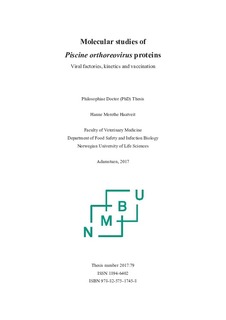| dc.contributor.advisor | Rimstad, Espen | |
| dc.contributor.advisor | Dahle, Maria | |
| dc.contributor.advisor | Wessel, Øystein | |
| dc.contributor.author | Haatveit, Hanne | |
| dc.date.accessioned | 2018-06-07T11:32:24Z | |
| dc.date.available | 2018-06-07T11:32:24Z | |
| dc.date.issued | 2018 | |
| dc.identifier.isbn | 978-82-575-1745-8 | |
| dc.identifier.issn | 1894-6402 | |
| dc.identifier.uri | http://hdl.handle.net/11250/2500835 | |
| dc.description.abstract | Piscine orthoreovirus (PRV) is ubiquitous in farmed Atlantic salmon (Salmo salar) and the cause of heart and skeletal muscle inflammation (HSMI). PRV is an orthoreovirus in the family Reoviridae and shows several similarities to the Mammalian orthoreovirus (MRV).
Reovirus non-structural proteins are involved in the establishment of viral factories, and viral factory-like structures have been observed in PRV infected Atlantic salmon erythrocytes. By fluorescent microscopy, dense globular inclusions resembling viral factories, formed by the non-structural protein µNS of PRV, were detected in transfected fish cells. In co-transfection experiments with μNS, the σNS, μ2 and λ1 proteins were recruited to the globular structures. Expression of the N-terminal 401 amino acids of the μNS protein did not induce viral factory-like structures, mapping this feature to the remaining C-terminal 351 amino acids.
By means of a cohabitant challenge lasting for 8 weeks, the kinetics of viral RNA, viral protein and antiviral immune response in blood cells from PRV-infected Atlantic salmon were investigated. The study showed that PRV infection has an acute phase in blood cells with high virus production and innate antiviral gene expression before the infection subsides to a low persistent level. Different size variants of the µNS and the outer capsid protein µ1 were observed at specific time points during infection. Interestingly, a proteolytic cleavage fragment of the µ1 protein was the only viral protein detectable 7 weeks post challenge, indicating that this fragment may be involved in the mechanisms of persistent infection.
At last, two experimental challenges testing different DNA vaccines against HSMI were performed. The results showed that a vaccine expressing the viral factory forming non-structural proteins µNS and σNS, in combination with the structural outer capsid protein σ1, induced moderate protection against HSMI in Atlantic salmon.
To conclude, our studies have shown that μNS is the main protein involved in viral factory formation during the acute phase of PRV infection and the protein, in combination with σNS and σ1, also has the ability to induce protection against HSMI when delivered as a DNA vaccine. | nb_NO |
| dc.description.abstract | Piscine orthoreovirus (PRV) er ubikvitær hos oppdrettslaks og årsaken til hjerte- og skjelettmuskelbetennelse (HSMB). PRV er et orthoreovirus i familien Reoviridae, og har flere likhetstrekk med Mammalian orthoreovirus (MRV).
Ikke-strukturelle proteiner fra reovirus er involvert i etablering av virusfabrikker ved infeksjon, og virusfabrikk-liknende strukturer er tidligere observert i PRV infiserte erytrocytter fra laks. Fluorescensmikroskopi viste virusfabrikk-liknende globulære inklusjoner dannet av det ikke-strukturelle proteinet μNS i transfekterte fiskeceller. I ett ko-transfeksjonsforsøk med μNS ble σNS, μ2 og λ1-proteiner rekruttert til de globulære strukturene. Det ble ikke observert virusfabrikk-liknende strukturer når kun den N-terminale delen av µNS ble uttrykt, noe som knytter denne egenskapen til de gjenværende 351 C-terminale aminosyrene.
Prøvemateriale fra et 8-ukers kohabitant smitteforsøk ble benyttet til å studere viruskinetikk, proteinkinetikk og antiviral immunrespons i blodceller fra PRV-infisert laks. Studien viste at PRV gir en akutt, massiv infeksjon i blodceller som kun strekker seg over noen få uker før fiskens immunrespons dirigerer infeksjonen over i en persistent fase. Ulike størrelsesvarianter av μNS og det ytre kapsidproteinet μ1 ble observert ved bestemte tidspunkter under infeksjon. Ett proteolytisk kløyvingsfragment av μl-proteinet var det eneste påvisbare virusproteinet 7 uker etter smitte, noe som indikerer at dette fragmentet kan være involvert i mekanismer som fører til persistent infeksjon.
Til slutt ble det utført to smitteforsøk hvor ulike DNA-vaksiner mot HSMB ble testet. Resultatene viste at en vaksine som uttrykte de virusfabrikk-dannende proteinene µNS og σNS, i kombinasjon med det strukturelle ytre kapsid proteinet σ1, induserte moderat beskyttelse mot HSMB i Atlantisk laks.
Våre studier har vist at μNS er hovedproteinet involvert i dannelsen av virusfabrikker og at PRV gir en akutt infeksjon av relativt kort varighet før infeksjonen går over i en persistent fase. Kombinasjonen av µNS og σ1, har evnen til å indusere moderat beskyttelse mot HSMB når de uttrykkes i en DNA-vaksine. | nb_NO |
| dc.language.iso | eng | nb_NO |
| dc.publisher | Norwegian University of Life Sciences, Ås | nb_NO |
| dc.relation.ispartofseries | PhD Thesis;2017:79 | |
| dc.rights | Attribution-NonCommercial-NoDerivatives 4.0 Internasjonal | * |
| dc.rights.uri | http://creativecommons.org/licenses/by-nc-nd/4.0/deed.no | * |
| dc.subject | Piscine orthoreovirus | nb_NO |
| dc.subject | PRV | nb_NO |
| dc.subject | Non-structural protein | nb_NO |
| dc.subject | MuNS | nb_NO |
| dc.subject | Vaccine | nb_NO |
| dc.subject | Heart and skeletal muscle inflammation | nb_NO |
| dc.subject | HSMI | nb_NO |
| dc.subject | Viral factories | nb_NO |
| dc.title | Molecular studies of Piscine orthoreovirus : viral factories, kinetics and vaccination | nb_NO |
| dc.type | Doctoral thesis | nb_NO |
| dc.relation.project | Norges forskningsråd: 237315/E40 ; 235788 | nb_NO |

